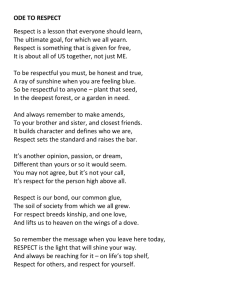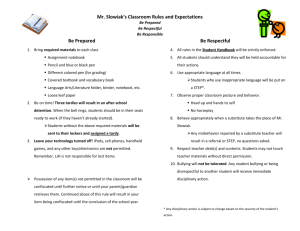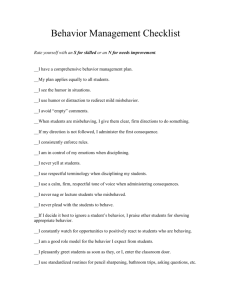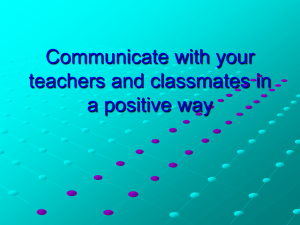to view my Behavior Modification Presentation and Resources
advertisement
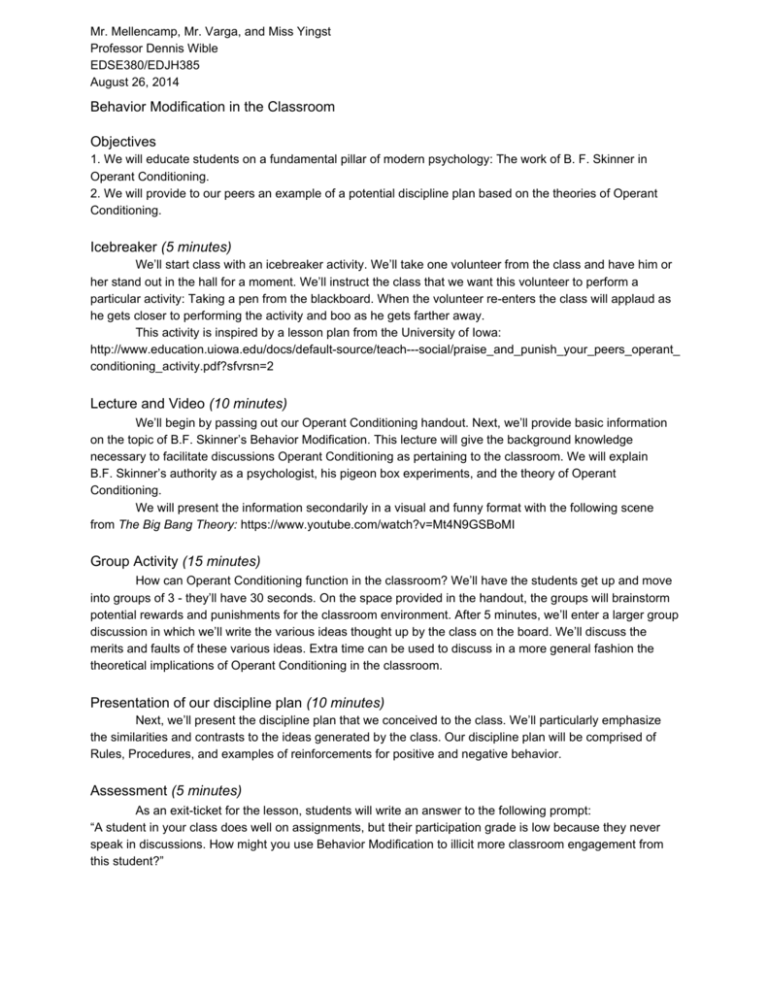
Mr. Mellencamp, Mr. Varga, and Miss Yingst Professor Dennis Wible EDSE380/EDJH385 August 26, 2014 Behavior Modification in the Classroom Objectives 1. We will educate students on a fundamental pillar of modern psychology: The work of B. F. Skinner in Operant Conditioning. 2. We will provide to our peers an example of a potential discipline plan based on the theories of Operant Conditioning. Icebreaker (5 minutes) We’ll start class with an icebreaker activity. We’ll take one volunteer from the class and have him or her stand out in the hall for a moment. We’ll instruct the class that we want this volunteer to perform a particular activity: Taking a pen from the blackboard. When the volunteer re­enters the class will applaud as he gets closer to performing the activity and boo as he gets farther away. This activity is inspired by a lesson plan from the University of Iowa: http://www.education.uiowa.edu/docs/default­source/teach­­­social/praise_and_punish_your_peers_operant_ conditioning_activity.pdf?sfvrsn=2 Lecture and Video (10 minutes) We’ll begin by passing out our Operant Conditioning handout. Next, we’ll provide basic information on the topic of B.F. Skinner’s Behavior Modification. This lecture will give the background knowledge necessary to facilitate discussions Operant Conditioning as pertaining to the classroom. We will explain B.F. Skinner’s authority as a psychologist, his pigeon box experiments, and the theory of Operant Conditioning. We will present the information secondarily in a visual and funny format with the following scene from The Big Bang Theory: https://www.youtube.com/watch?v=Mt4N9GSBoMI Group Activity (15 minutes) How can Operant Conditioning function in the classroom? We’ll have the students get up and move into groups of 3 ­ they’ll have 30 seconds. On the space provided in the handout, the groups will brainstorm potential rewards and punishments for the classroom environment. After 5 minutes, we’ll enter a larger group discussion in which we’ll write the various ideas thought up by the class on the board. We’ll discuss the merits and faults of these various ideas. Extra time can be used to discuss in a more general fashion the theoretical implications of Operant Conditioning in the classroom. Presentation of our discipline plan (10 minutes) Next, we’ll present the discipline plan that we conceived to the class. We’ll particularly emphasize the similarities and contrasts to the ideas generated by the class. Our discipline plan will be comprised of Rules, Procedures, and examples of reinforcements for positive and negative behavior. Assessment (5 minutes) As an exit­ticket for the lesson, students will write an answer to the following prompt: “A student in your class does well on assignments, but their participation grade is low because they never speak in discussions. How might you use Behavior Modification to illicit more classroom engagement from this student?” Behavior Modification in the Classroom Mr. Mellencamp, Mr. Varga, & Miss Yingst Let’s Break The Ice Volunteer, please! B.F. Skinner - Burrhus Frederic Skinner (1904-1990) - B.A. in Literature at Hamilton College, NY. - M.S. and Ph. D in Psychology at Harvard University. - Taught and researched behavioral psychology at the University of Minnesota, Indiana University, and Harvard University. What is Behavior Modification? - Behavior techniques to increase or decrease the frequency of a behavior. - Altering human behavior as part of a learning or treatment process. - Skinner’s Box and Pigeon Experiments. Positive Reinforcement Increase a behavior by adding a stimulus. Negative Reinforcement Increase a behavior by removing a stimulus. Presentation Punishment Decrease a behavior by adding a stimulus. Also known as Positive Punishment Removal Punishment Decrease a behavior by removing a stimulus. Also known as Negative Punishment Let’s take a look at these principles in action Rules 1. 2. 3. Students will be prepared for class (books, writing utensils, assignments, etc.) Students will be respectful of others and property. Students will be positive, engaged, and participatory. Consequences 1. 2. 3. Students not prepared for class (books, writing utensils, assignments, etc.) a. Book i. Students will use an inclass copy of the book with personal collateral (student ID, cell phone, etc). b. Writing Utensil i. Students will use the “flower pen/cil” and return it at the end of class c. Assignment i. Student work will be accepted until the end of the school day with a 5% penalty. Students who are not respectful of others and property. a. Not respectful of others i. Student will apologize for their actions and say what they should have done instead. b. Not respectful of property i. The teacher will contact the student’s parent/guardian about the disrespect of property. Students who are not positive, engaged, and participatory a. Students will “Take Five” and sit at the side/back of the room until they are ready to rejoin the group and take part in the activity. Rewards 1. 2. 3. Students will be prepared for class (books, writing utensils, assignments, etc.) a. If all students are prepared for class, they will have extra time for homework, class activities, and projects. Students will be respectful of others and property. a. If all students are respectful of others and property, the class shall be rewarded with a more pleasant classroom atmosphere. Students will be positive, engaged, and participatory. a. If all students are engaged, they will have a “fun and games” learning or review activity. B.F. Skinner: Behavior Modification Diagram of Behavior Consequences: Give Take Increase Behavior Decrease Behavior Group Discussion Question: What are possible rewards and punishments that you can use in your classroom? Exit­Ticket Question: “A student in your class does well on assignments, but their participation grade is low because they never speak in discussions. How might you use Behavior Modification to illicit more classroom engagement from this student?” Mr. Mellencamp, Mr. Varga, and Miss Yingst Professor Dennis Wible EDSE380/EDJH385 August 26, 2014 Behavior Modification Discipline Plan Rules 1. Students will be prepared for class (books, writing utensils, assignments, etc.) 2. Students will be respectful of others and property. 3. Students will be positive, engaged, and participatory. Consequences 1. Students not prepared for class (books, writing utensils, assignments, etc.) a. Book i. Students will use an inclass copy of the book with personal collateral (student ID, cell phone, etc). b. Writing Utensil i. Students will use the “flower pen/cil” and return it at the end of class c. Assignment i. Student work will be accepted until the end of the school day with a 5% penalty. 2. Students who are not respectful of others and property. a. Not respectful of others i. Student will apologize for their actions and say what they should have done instead. b. Not respectful of property i. The teacher will contact the student’s parent/guardian about the disrespect of property. 3. Students who are not positive, engaged, and participatory a. Students will “Take Five” and sit at the side/back of the room until they are ready to rejoin the group and take part in the activity. Rewards 1. Students will be prepared for class (books, writing utensils, assignments, etc.) a. If all students are prepared for class, they will have extra time for homework, class activities, and projects. 2. Students will be respectful of others and property. a. If all students are respectful of others and property, the class shall be rewarded with a more pleasant classroom atmosphere. 3. Students will be positive, engaged, and participatory. a. If all students are engaged, they will have a “fun and games” learning or review activity.
